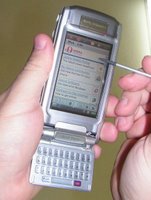
The Sony Ericsson P910 is the Sony Ericsson P900 smartphone's successor. The P910 has a full QWERTY keyboard on the back of the flip (The flip can also be removed completely, allowing for a 'traditional' PDA form-factor. The biggest change from the P900 to the P910 is that the P910 now supports Memory Stick Pro Duo (up to 1GB) and the phone's internal memory has been upped from 16MB to 64MB. Although Memory Stick Pro Duo comes in larger capacities, the maximum supported by the P910 is 1GB owing to performance lags. It is powered by an ARM9 processor clocked at 156MHz and runs the popular Symbian OS with the UIQ graphical user interface. Also, the touchscreen displays 262,000 colours (an 18-bit colour depth) , as opposed to the P900's 65,000 (16-bit). It comes in three flavors:
- P910i (GSM 900/1800/1900)
- P910c (GSM 900/1800/1900 for China mainland)
- P910a (GSM 850/1800/1900 for North America and Latin America)
One of the key aspects of the P910 is its ability to input text via several methods; multi-tap and T9 text input using the numerical keypad, hand-writing recognition with the pre-installed Jot-Pro software and touchscreen, virtual keyboard on screen and the new QWERTY keyboard on the inside of the flip.
Other enhancements over the P900 include support for HTML browsing, a new numerical keypad with larger keys and a slightly changed outer casing.
Its closest competitors are the palmOne Treo 650, and the Nokia 9500 Communicator.
Other competitors include several PDA-phones powered by Windows and manufactured by Taiwan-based HTC.
Sony Ericsson will be releasing the successor to the P910 in early 2006. It will be called Sony Ericsson P990.
Specifications
- 208x320 screen resolution
- 65,000 color touchscreen LCD
- Symbian OS 7
- UIQ 2.1
- 115 x 57 x 24 mm in size
- GSM 1900/GSM 900/GSM 1800
